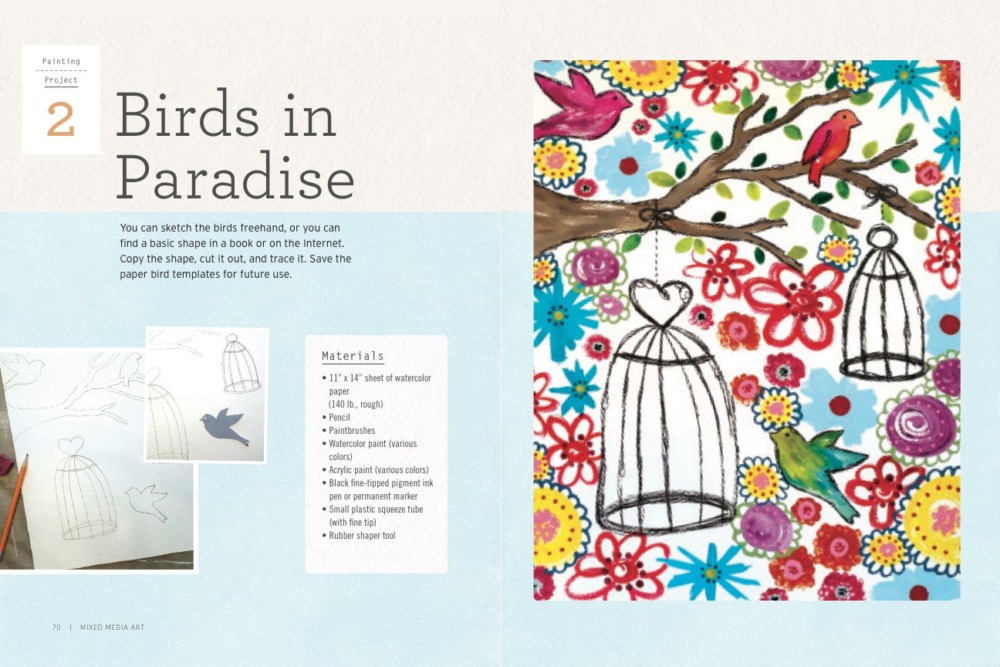Thank you for visiting!
Since getting an advanced degree in art several years ago, I’ve known that the direction of contemporary art has been leaning more and more into the interrelationships of the past and present, the high and the low, “fine” and “pop,” in both collusion and collision — often, all at once. But how to represent that in my own works? Other than, say, making monumental sculptures out of balloon animals? But then I noticed how many artists since Picasso have integrated mixed media into collages, paintings, and other assemblages, turning seemingly random media and objects into insightful and incite-ful works of art.
I was sooo happy to get this great book. It looks at the technical aspects of how to work with, say, newspaper clippings, melted wax, stencils, and paintings — all at once! It is a large, well-bound, well laid-out, and well written book, with abundant illustrations, photos, and diagrams throughout, in a style befitting the subject. There are sections on getting started (including creativity exercises — what I really needed), paints (including watercolor, ink, acrylic), papers (including tissue, craft, newspaper and magazine clippings), fibers, stamps, stencils, found and repurposed materials, embossing, encaustics, and much more. There are specific projects in each major section, though each can go in many directions — as far as your creativity takes you. It’s really a GREAT book on the topic(s), and really helpful throughout.
I have admired and wanted to emulate the mixed media classic works of art that every art textbook has featured since they gained art-world prominence by artists in the Fifites and onward, in turn looking back at Dadaist assemblages and the random bits of printed papers painted into Cubist paintings and collages by Picasso and Braque. But working with mixed media in an aggressive way wasn’t something offered in any serious way at the colleges I attended. So I am delighted to get a hold of this wonderful encyclopedia, if you will, of professional approaches to working with media and materials that were often not intended to be worked with in artistic ways.
The book is a well designed paperback with excellent printing and layout and utterly filled with fantastic photos of both completed works and during their construction. Six different artists contribute their vast experience and expertise into real-life instructions and tips, all condensed into over 80 specific topics/media/approaches, grouped into 11 chapters: painting backgrounds, gesso & mediums, art journaling, found & repurposed materials, stamping, stenciling, altering photographs, transferring (which includes working with inkjet and laserjet printed imagery — very helpful!), encaustics, papers, and adding texture. The topics are wide and deep, with topics like “Paint Drips, “Using Organic Matter,” “Transfer on Wood,” “Layering Transparent Papers,” and much more. If you want to work in collages (outside of Photoshop), this is what you need.
Confession Time: I’ve worked as an artist for many years now, but still struggle with what the heck am I supposed to do with color wheels and theories and palettes and I-don’t-know-exactly-what. I mostly work digitally, where pulling a color palette from an online tool is often easier than not. But when working with paints and physical media, I… um…? This is a large, saddle-stitched, 40 page introduction and actual explanation of how and why one coordinates colors using a color wheel and related tools. Topics like temperature and mood are covered, along with techniques for mixing colors in non-accidental and non-random ways, which I’m afraid is a kind of new thing for me. The book is well designed, written clearly and helpfully, and features tons of large diagrams and photos throughout that are truly helpful.
The hardest thing for me to improve on with my painting, and I suppose everything else in my life, is that I have trouble recognizing what I don’t know. I know I don’t know (many) things, but what those actually are is difficult to a troubling extent. I just look at my work, which is sometimes just not as professional as I like. But I wasn’t sure why. Then I remembered a professor contrasting how one of the Impressionists always used the same brush strokes for… everything, whereas another used different brush strokes to create, say, different textures for things like the sky, the water, fabrics, or skin.
All of which, I have found actually have different textures IRL. Bingo. Okay, so that’s what I didn’t know I didn’t know. Now what? And that’s where this excellent encyclopedia of painted textures comes in. It offers dozens of specific textures and approaches within six larger chapters: People, Animals & Insects, Fabrics & Textiles, Food & Beverages, Nature, an introduction to a wealth of introductory painting techniques (several which I’d never heard of), and a catch-all chapter that covers glass, ceramics, stone, woods, and metals. There are wide-ranging — and super helpful — sections on topics like, “Smooth Canine Fur,” “Curly Canine Fur,” “Aged Wood,” “Palm Frond,” “Smoke,” and “Eye.” I’m learning a lot from this excellent book.





